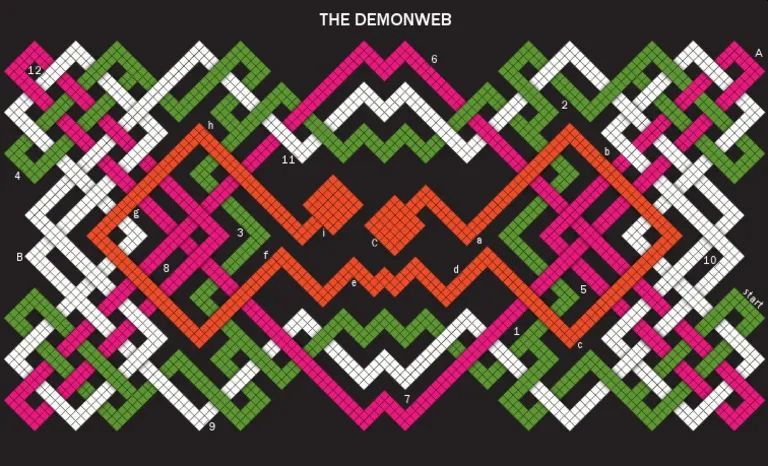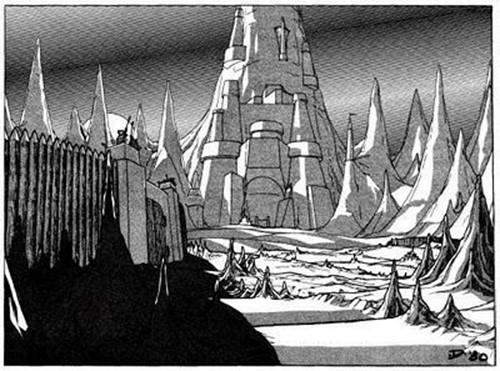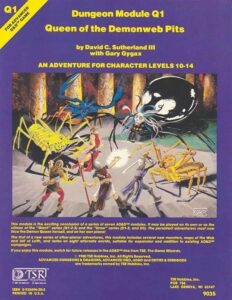The publication of Q1: Queen of the Demonweb Pits in 1980 was an important event. After about a two-year wait, we finally had the conclusion to the Giant and Drow series. However, the author of the adventure wasn’t Gary Gygax, who’d written the first six modules, but instead Dave Sutherland.
Gygax explained the substitution in the adventure – he had written the first six modules over a six-month period, and then had moved to the DMG (which was already behind schedule). After then, “As I was reviewing my ideas for DEMONWEB, it suddenly struck me that what I had sketched out was far too similar to another module ‘rough’ that I was committed to: the TEMPLE OF ELEMENTAL EVIL, the final part of the VILLAGE OF HOMMLET…
“Finishing a module from an outline is not a difficult task. Creating a whole new setting is, and that was exactly what was required for one or the other of the modules I was committed to. Then one day, as I was talking with Dave, the quandary was resolved. He showed me an idea he had for a “dungeon” level, and what a level! This, I told him, was the perfect setting for the DEMONWEB, and straightaway placed the entire project into his capable hands…” (March 1980)
And so we believed, and we accepted the module for what it was. However, many years later, the story from Gygax wasn’t the same…
“I did not write [Q1], nor did I approve of it. Complain to the Blumes, for they insisted on publishing it against my objections.
“As for the chief antagonist, it was meant to be Eclavdra on behalf of the EEG, with the minions of Lolth, not the demoness per se., being second and a counterweight to the former as noted. The latter will fight against the Eilservs and tolerate for a time the presence of a PC party that is discommoding their foes.” (It’s somewhere in this thread – the original link no longer works.)
Gygax’s later comments reveal a troubled history of the adventure, and the conclusion of one of the greatest series of D&D adventures was not what we were expecting.
I first encountered Queen of the Demonweb Pits when I became interested in D&D. It was one of the modules I borrowed from a friend, and it immediately interested me. The module was very attractive: two nested covers, and a 32-page booklet with a lot of good art and the adventure. Most striking of all was the map of the Demonweb.

The story goes that it was inspired by a towel design that Dave Sutherland had seen. The way it’s constructed, with the various levels all being perfectly flat but weaving under and over the others worked perfectly for me. It all seemed very chaotic and strange, and very much a proper “demonweb”.
I still maintain that opinion, but the module as written manages to take away from the chaotic nature of the demonweb by making it so that the characters might never notice! It’s astonishing: the characters have to be actively looking for overpasses and underpasses, which in the normal scheme of things they’d never do, and they can navigate the entire demonweb just by finding the teleportation rooms that lead up to the next level. In essence, you get a depressingly linear dungeon adventure.
Thankfully, the characters will notice when a wandering monster floats down from an upper level, which isn’t that unlikely: a 1 in 6 chance EVERY TIME they pass under an overpass. The demonweb is a dangerous place. (This might be somewhat of an overkill of random encounters; I count 5 or 7 overpasses depending on direction before the first actual keyed encounter is found).
However, I expect that if I ever manage to run this most unusual of modules, I’ll make it quite clear to the players when they’re passing under or over another pathway… because it will really confuse them as to what level they’re on!
The entire demonweb is made more difficult by five pages of text explaining how spells work differently in the Abyss. I’m conflicted about this listing: it’s astonishingly clunky (and makes no allowance for spells being added to the lists later) and frustrating for the players, but it does add to the alien nature of the place and its menace. Having the Regenerate spell give an 80% chance of the limb growing back incorrectly (insect, tentacle, etc.) is quite evocative.
More troubling is the rule that magic items reduce their bonuses on the Abyss: two plusses are subtracted from all weapons, armour and other protective items. This can be deadly for those involved in this adventure, as many of the demons require a magic weapon to hit (to say nothing of Lolth). Interestingly, drow armour and weaponry are not affected, as they derive their power from this place, but Sutherland did not think of the converse: shouldn’t they be weaker in the Vault?
The keyed encounters in the web are quite amusing and of varied difficulty. They very much give a variety of challenges for the party to overcome; I’m quite fond of the cleric guarding some trapped maidens, with each side accusing the other of being evil. There are a number of encounters here to make the players think in addition to more mundane combat encounters, and I’m very fond of that.
The fourth level of the web is outstanding: it contains gateways to other worlds that Lolth is trying to conquer. Although the worlds beyond are only briefly described, they are tremendously evocative and there’s enough detail for a DM to run a short adventure in each and to expand them if desired. It helps that the art for Maldev, one of the worlds, really catches my attention.

The ultimate goal of the party is the dwelling of Lolth and, surprisingly, it is on a castle-sized mechanical spider ship. These days, we’d probably describe it as “steampunk”, but it all seemed very strange and unusual back when it was published. The map for the spider ship breaks it up into seven levels, and there are 38 encounter areas in all.
The lower levels of the ship are filled with monsters – demons, bugbears, trolls, giants, spiders, and dragons! A full 26 of the areas have monsters in them. Most of the areas are briefly described and are fairly mundane in aspect, but the control rooms of the ship and Lolth’s quarters and throne room are better detailed and far more interesting.
Lolth herself gets a two-page write-up at the end of the adventure, including optional abilities for using her as a lesser goddess (which would make her all but unkillable by your regular party). Even without those extra powers, she’s not a pushover. While she has only 66 hit points, a 70% Magic Resistance and a -10 AC – as well as sundry other immunities – make her very difficult to fight.
One tale I was told as a teenager involved a thief killing her with a backstab… but as Lolth had a fire shield active at the time, the thief took enough damage from the blow to die himself!
Apart from Lolth, the module includes a number of new monsters including the Drider, three sizes of Pedipalp, two sizes of Scorpion, three sizes of Solifugid, and the Yochlol (Handmaiden of Lolth). The drider and yochlol are inspired monsters, and given their later significance, it always surprises me that they first appeared here and not in D3!
All in all, I’m rather fond of Q1, for despite its numerous rough patches and unexpected design decisions, there’s a lot of creativity on show here, and it does make for a rather memorable adventure. The major problem with it is that it has little to do with the Giant and Drow series that it’s meant to conclude.
The story Gary Gygax set out in the G and D modules involved the plans of a splinter group of drow (led by Eclavdra) in the service of the Elder Elemental God. When their plans failed, they brought down the wrath of the upper word (that would be the adventurers) onto the drow. Somehow, that changes into a attack against Lolth by the party, sponsored by the nobles of the world above. Of course, it doesn’t help that Gygax managed to make most of the Vault of the Drow about Lolth and gave scant mention to Eclavdra and the Elder Elemental God. From this vantage point in time, the final result is less than it should have been.
This inconsistency was picked up when TSR later released the Queen of the Spiders supermodule, which collected the entire sequence into one publication. I’ll write more on that at a later date.
This, unfortunately, would not be the only major project that Gary Gygax never finished; the Village of Hommlet would be left languishing for even longer before Frank Mentzer released the (inferior) Temple of Elemental Evil, and other planned projects would fail to materialise. There would be great products in the future from Gygax, but the failure of this module to be written by him portended ill for the future.


Looking forward to reading your review of the collected GDQ module as I only ever bought the individual modules.
I’ve really appreciated this walk down memory lane. I was an early adopter – started playing in the mid-late 70’s in college. At a social gathering the husband of an acquaintance asked my to introduce he and a few friends to the game. Twenty-somethings. I did. They were hooked. And they played together for years although I never DM’d for them again after that first session. I don’t even recall what I ran. But half a decade later I got a phone call. They were ready to wrap it up. And they wanted me to do it. They rented a suite at a hotel here in C-bus. I pulled an all-nighter on Wednesday, took my last exam of the quarter on Thursday, then drove down to sleep as long as I could before the marathon. They’d provided me their character sheets and I’d reviewed them. I was just gonna “de-power” some of their more ridicules stuff but provide the adventure they wanted. I ran the entire G series, then the entire Descent into the Depths, culminating with the Queen. They’d taken Friday off and we started promptly at noon. I would excuse players for food runs and, once we got into Saturday, nap breaks. Hill Giants fell. Frost Giants. King Snurre. They had a couple of close calls pushed on. Through the Drow. Through the Shrine of the Kuo-toa. In the vault they finally lost one. He was the youngest player. Made a rash decision. We took a break and this group of grown men wept for their fallen comrade. A pretend elf.
We finished up on Sunday afternoon. Exhausted. United. Happy. And I appreciate you taking me there again.
Wow! What an amazing story! It just shows you what can be possible. Doing the whole series over a weekend would be intense.